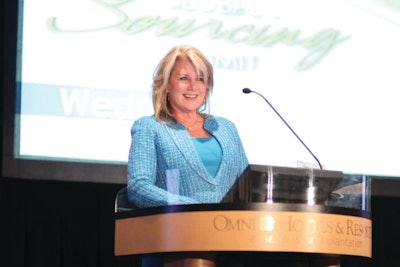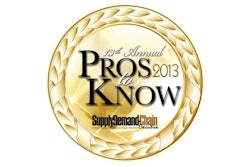
Supply chain executive leaders—you may want to think again before you make the strategic decision to cut your workforce staff. The move in cutting headcount—perhaps one of the most traditional routes to cut costs immediately for example, such as with a merger or acquisition—is one that presents a lot of factors for consideration before enacted. ‘What happens to your workflow? Is it still the same? And who is now mitigating that volume to keep business moving? Or are you outsourcing that workflow to a third party? And if so, was it a more effective strategy?’
Even more evident is the fact that retaining strong talent is among the biggest concerns amongst end users in the global supply chain today across all industries, a topic which resonated strong at SIG’s Global Sourcing Summit this past May, held at the Omni Amelia Island Plantation Resort in Amelia Island, Fla. This month, we caught up with Dawn Tiura Evans, President and Chief Executive Officer of SIG to uncover why this is such a topic of concern today; what challenges SIG’s members face as they work to address them; and what is on the forefront for SIG in helping its members retain top talent.
SDCE: Strong talent retention was an important topic for your members at your semi-annual SIG Global Summits last year. Was that still a top area of concern for this year’s spring event or were there other key topics that resonated more concern?
Evans: Talent management and talent acquisition are still huge topics today. There’s discussion in the industry that the workforce—domestically if not internationally—will be 50 percent contingent by 2020. So there is a lot of questioning around ‘Could that possibly be true?’ Beyond that, it’s really more about the logistics. ‘Where are we going to find the right people? How are we going to deal with contingent workforce? And how are we going to deal with so many people that want to work remotely, with the new generation coming into the workforce?’ A lot of generation X and Y want to be more mobile. So the question becomes ‘Is it better to have a person like that who really is a rock star? Or is it better to have a solid employee who will show up in your office on time and be available for face-to-face interaction?’
There’s also more conversation around risk than we’ve ever had before—risk in the supply chain due to globalization and growth from a sourcing and non-sourcing perspective. You really have to have more insight into your second-tier suppliers than has ever been required, not to mention it’s a lot harder in different countries due to language, customs and taxations. There’s also the fact that a lot of second-tier suppliers around the world are not incorporated, so a lot of access information is limited.
There’s also discussion around conflict minerals, at least from a domestic U.S. focus, with such questions as: ‘Has the government overstepped their bounds? And is this the start of even more regulations on your supply chain than we’ve ever had before?’
SDCE: What are some of the ways that your members are addressing their workforce issues? Are there certain talent service platforms that they are using?
Evans: The technology is going to come more from the vendor management service (VMS) providers than companies are going to develop internally. There is a lot of talk now about VMS and the different providers in that space. A lot of folks just need to get their arms around how many people it takes to run their company—and a lot of people right now are just starting to answer that question. So if you take your contingent workforce—whether it be your independent contractors, your consultants or your outsourced employees—there are very few companies that have their arms around how many people on any given day are actually working for the company. A lot of folks have been surprised at the number of contingent workforce individuals that are working for their company on a day-to-day basis. That is where a lot of the VMS type of suppliers have a big play, as they come up with technology to capture all that—to manage these contracts; to identify the employees and how long they have been employed within your firm; and to identify where there is risk.
SDCE: So what is the first step to addressing the workforce issues?
Evans: You want to retain the talent you have but first you need to know who is working for you. This is a procurement imperative but HR also has got to get their arms around it. Otherwise, you can’t reward and retain top talent. The old grading curve in corporate America in being paid based on pay scales or pay curves— that does not work for the really sharp supply chain person these days. So it’s the idea of: ‘I’m not a number on your curve. If I’m producing, I want to be rewarded and compensated for my performance, not based on how long I’ve been here or what number I am on your pay scale’ or some archaic rule that’s been in place for years and years to manage the workforce. That is a huge change for HR to get their arms around to move forward. So for attracting and retaining the right talent to work properly—it can’t be done single-handedly in the supply chain. The rest of the company must stand up and get behind the person driving the effort to change this. And that is the biggest issue.
SDCE: Are there any new initiatives that SIG is rolling out this year to help its members address their talent retention challenges?
Evans: We have a “Peer to Peer” (P2P) program which is an actual, live discussion around commodities, processes, technologies and many other issues. Our members can register, state their focus areas from a category-, BPO- or technology perspective and then link up with other professionals in their area of expertise across our online portal. So let’s say I’m sourcing facilities. Through Peer to Peer, I can now talk to anyone who is sourcing facilities to say ‘I’m moving to a new region in Europe—which supplier there is good to use?’ We’re helping people build their professional networks for their workforce so that they can have those conversations. We are also sharing the collective knowledge of our members with other professionals to open up more dialogue on talent. We have spoken at numerous industry events on talent management and acquisition and always share the latest best practices that we are acquiring from member companies. In addition to that, we’re enhancing our SIG Resource Center. We’re building out category playbooks on dozens of new categories and getting more access into tools and templates and methodologies. Our physical networking is for the senior executives, but they all have teams. So we’re really trying to help the executives help their staff continually.













